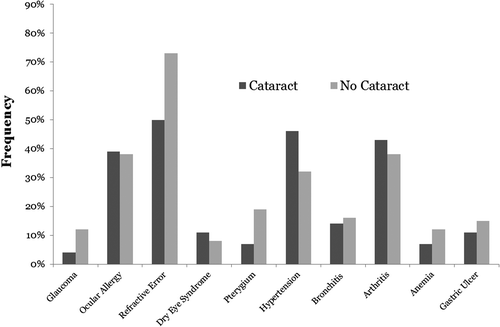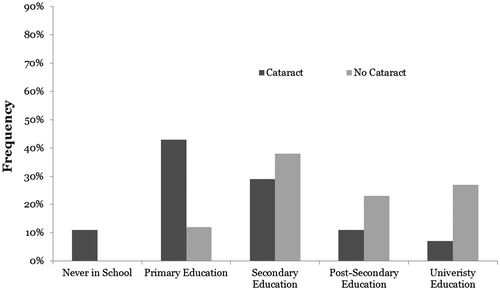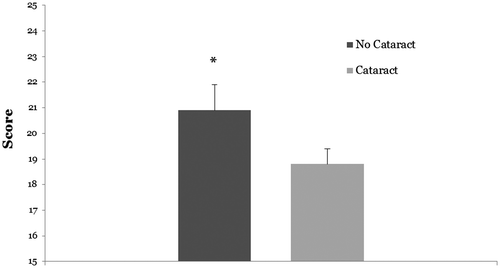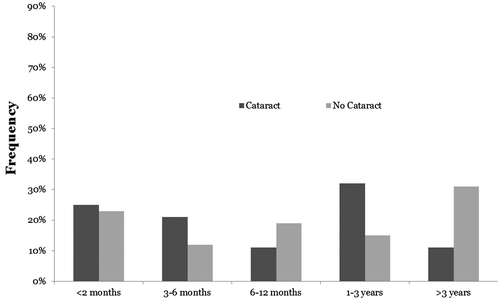Abstract
Purpose: Cataract is a leading cause of visual impairment globally. This study explored medical, behavioral, and socioeconomic factors associated with cataract development in a rural community in Imo State, Nigeria. Methods: A case-control study was done on 61 patients above 40 years old from a medical outreach program to determine the presence of cataract and its risk factors. Results: Of 54 complete records, 52% had cataracts (while 48% had no cataracts). There were no significant differences in co-morbidities such as ocular allergy (OR 0.98, 95% CI: 0.36–2.69), refractive error (OR 1.46, 95% CI: 0.61–3.50), hypertension (OR 0.66, 95% CI: 0.24–1.89), or arthritis (OR 0.90, 95% CI: 0.33–2.43) between people with or without cataract. The no cataract group had a higher educational level (p = 0.01) and socio-economic score (SES, 20.9 ± 2.9 vs. 18.8 ± 3.0, p = 0.01). Both groups obtained medications without a prescription (OR 0.95, 95% CI: 0.40–2.28), and had equivalent sun exposure (3.4 ± 2.9 vs. 3.9 ± 2.2 hours, p = 0.31), use of multivitamins (p = 0.80), sunglasses (p = 0.32), and hats (p = 0.83). Conclusion: Poor knowledge and use of cataract risk reducers in the community contributed to development of cataracts, regardless of socioeconomic status.
Public Interest Statement
Cataract is a disease that causes decreased vision due to progressive opacification of the lens of the eye. For those who have access to modern medicine, cataracts can be treated with a short, outpatient surgery. However, in developing regions of the world, surgery to remove cataracts is available to relatively few. In these places, cataracts devastate the personal and socioeconomic wellbeing of millions. Imo State is a rural, developing region of Nigeria that has an unusually high number of adults with cataracts. This study aimed to identify causes of the high rate of cataracts in this area. To do so, we compared the lifestyle, education, and health care habits of adults with cataracts to those without cataracts in Imo state. This comparison demonstrated that having a higher level of education or a higher socioeconomic standing correlated with a lower risk of cataract. Understanding the interaction between social class, education and cataract will help guide future initiatives to reduce the burden of cataracts in this region.
Competing Interests
The authors declare no competing interest.
1. Introduction
Short-term medical missions (STMM) allow medical practitioners to utilize their skills to diagnose and address treatable diseases, like cataracts, in resource-limited regions around the world. Located in a very resource limited area of western, sub-Saharan Africa, Nigeria is the most populous country in Africa, and ranks eight among the 10 countries with the world’s largest population, with an annual growth rate of 2.5% (Brockway & Hay, Citation1998). Nigeria has more medical professionals than other countries in the region, yet still has relatively low average life expectancy at birth (53 years) (Brockway & Hay, Citation1998) and a high under-five mortality rate (Wasunna & Whitelaw, Citation1987).
In a prior community needs assessment survey conducted during a volunteer medical outreach team, where over 2000 patients were cared for in Imo State, Nigeria, 747 patient records were reviewed and visual complaints were noted to be the most prevalent medical condition in all age groups (69% of patients) (Mezu-Ndubuisi, Mezu-Nnabue, Vo, & Mezu-Nwaba, Citation2014). Cataracts were found to be present in 17% of the general population and 64% of the adult working population above 40 years old (Mezu-Ndubuisi et al., Citation2014). Cataracts are the more common cause of low vision worldwide, most notably in Africa and other low resource countries (Mahdi et al., Citation2014; Ono, Hiratsuka, & Murakami, Citation2010). Low vision and blindness have widespread social, economic, and personal ramifications (Roth, Citation1977). Furthermore, of the vast majority of those with visual impairment (90%) live in developing regions of the world and of the major causes of visual impairment, cataracts are the second most common (Shweiki, Itin, Soffer, & Keshet, Citation1992). In Nigeria, cataracts account for the single, most prevalent cause of preventable blindness in the country (Abdull et al., Citation2009). Age is a consistent risk factor for cataract formation, but the progression of clinically significant cataracts may be affected by other associated factors. A potential focus of preventive health care efforts in this region is reduction of low vision due to cataract, a treatable eye disease, responsible for approximately 50% of global blindness which has significant socioeconomic consequences (Morley, Morley, Sanguansak, & Kusakul, Citation2015; Roth, Citation1977). Delaying the onset of cataracts by 10 years has been shown to reduce the need for cataract surgery by 50% (Pastor-Valero, Citation2013). Previously investigated risk factors for cataract development include ultraviolet (UV) radiation exposure, poor water-sanitation (Gupta, Rajagopala, & Ravishankar, Citation2014; Yam & Kwok, Citation2014), low-antioxidant diet, smoking, infrequent exercise, chronic malnutrition and dehydration (Pastor-Valero, Citation2013; Wang, Han, Jiang, & Zhang, Citation2014; Williams, Citation2013). Although a diet that is low in anti-oxidants is associated in increased risk of cataracts, large supplementation trials have been controversial or largely negative (Mathew, Ervin, Tao, & Davis, Citation2012). It is important to note that these studies were conducted in temperate climates of industrialized nations with good basic diet and limited exposure to ultra-violet solar radiation, unlike developing countries. Accordingly, it is feasible that long-term, preventative, correction of antioxidant vitamin deficiencies may be more efficacious in preventing cataract formation in populations with poor nutrition and elevated exposure to ultra-violet radiation (Mahdi et al., Citation2014; Murthy et al., Citation2007).
The role of cultural norms, religion, traditional medicines and procedures such as couching (a relatively common, crude, procedure involving use of a common tool to push the lens into the aqueous portion of the eye), or inappropriate pharmaceutical use in the pathways to vision care is of particular interest, as these have been explored in other communities in the past, but specific interventions to alter these paradigms has not been fully investigated (Gilbert et al., Citation2010; Isawumi, Kolawole, & Hassan, Citation2013; Mahdi et al., Citation2014; Onwubiko et al., Citation2014). The cost of surgical treatment of cataracts are largely prohibitive in the areas where the burden of cataracts is the greatest, such as rural Nigeria (Gilbert et al., Citation2010; Odugbo, Mpyet, Chiroma, & Aboje, Citation2012).
Accordingly, a better understanding of the precipitating factors for cataract development in these regions is essential to reduce the burden of this disease on a large scale in this region. Investigating the prevalence of risk factors and risk reducers for cataracts in this population, the baseline degree of understanding of these factors within the patient population, and the treatments that patients currently seek for their cataracts is crucial to targeted development of future medical outreach and educational programs in the region. Other studies have described the inverse relationship between socioeconomic status, educational achievement and cataracts and we aim to validate these findings with this study, albeit in a novel region—South-Eastern Nigeria Ulldemolins, Lansingh, Valencia, Carter, & Eckert, Citation2012). Additionally, this study is the first to our knowledge to investigate the association between cataracts and health care behaviors, such as frequency of medical visits and method of obtaining prescription medications. This study also uniquely investigates the relationship between preventive behaviors, such as frequency of brimmed hat or UV-protective sunglasses use, with cataracts in the setting of a rural population in sub-Saharan Africa.
2. Materials and methods
The study adhered to the guidelines of the Declaration of Helsinki and was approved by the Federal University of Technology Owerri (FUTO) Institutional Review Board. Patients were consented to participate in the study.
2.1. Design of questionnaire
A questionnaire was designed to evaluate the patient’s socioeconomic status, medical history, dietary habits, as well as their knowledge of visual disease risk factors and risk reducers. Socioeconomic status and educational achievement were graded in order to quantify differences in comorbidities, general health behaviors, and knowledge of preventive visual health measures.
2.2. Subject selection
A case-control design was used with 61 subjects selected from over 2,000 mission attendees over a three-day period. Subjects were aged 40–88 years old. Cataract was defined as evidence of 2+ or more nuclear sclerosis in either eye as determined by a licensed optometrist or ophthalmologist. About 28 subjects were female and 33 subjects were male and 32 subjects had cataracts and 29 subjects had no cataracts. The study sample size of 61 subjects (32 cataract cases, 29 non-cataract controls) provided 43–88% power to detect anticipated large odds ratios ranging from 3.0 to 6.0 for comparing the incidences of major comorbidities and risk factors between cases and control at the two-sided 0.05 significance level, assuming incidence rates in the control group ranging between 30 and 60%.
2.3. Data analysis
Categorical variables were summarized in terms of frequencies and percentages while continuous variables were summarized in terms of means ± standard deviations (SD). Logistic regression analysis, Chi-square or Fisher’s exact test was used to compare categorical variables between cases and control. Odds ratios (OR) were reported along with the corresponding 95% confidence intervals. The comparisons of continuous variables (social economic scores, hours of unprotected sun) were compared between cases and controls using a two-sample t-test. All p-values were two-sided and p < 0.05 was used to define statistical significance. Data analysis was conducted using SAS software (SAS Institute Inc., Cary NC), version 9.4.
3. Results
Reasons for seeking care were compared between subjects with cataracts and those with no cataracts. The most frequent reason for seeking care were eye complaints in both groups (57% for cataracts, 54% for no cataracts). Suspicion of malaria and joint pain were also equally common complaints in both groups (malaria: 11% for cataracts, 27% for no cataracts; joint pain: 18% for cataracts, 19% for no cataracts) (Figure ). Subjects with cataract were significantly older than those without cataract (63.4 ± 11.6 years vs. 50.3 ± 7.8, p < 0.001).
Figure 1. Major reasons for seeking care at the medical mission for subjects with and without cataracts.
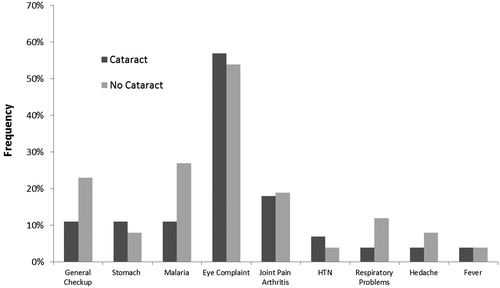
The most common comorbidities in both the cataract and no cataract groups were refractive error (50% of cataract group, 73% no cataract group), hypertension (46% cataract group, 32% no cataract group), arthritis (43% cataract group, 38% no cataract group), and ocular allergy (39% cataract group, 38% no cataract group). No significant difference in comorbidities was observed between the cataract and no cataract groups (Figure ).
In terms of schooling, the no cataract group had a significantly higher educational status (p = 0.013). Of those with cataract, 11% had no formal education while all of the no cataract cases had at least some formal education. In subjects with cataract 43% had proceeded through primary school only compared to 12% of those with no cataract. Subjects without cataracts had a larger proportion of people reporting a post-secondary education or higher (50% of no cataract controls versus 18% in cataract cases) (Figure ).
In addition, the graded socioeconomic status of the no cataract group was significantly higher than the cataract group (20.9 ± 2.9 vs. 18.8 ± 3.0, p = 0.011). Factors that contributed to socioeconomic score include ownership of a motor vehicle, number of individuals sleeping to a bed in the household, and drinking water source (Figure ).
Between both groups, the frequency of medical visits was low. Although, 31% of the no cataract group reported not seeing a doctor in over 3 years compared to 11% in the cataract group, this was not statistically significant (p = 0.234) (Figure ). In line with the low rate of preventive medical visits, both groups had an equally high rate of obtaining medications without prescription (61% of cataract group, 58% of no cataract group, p = 0.999).
Suspected cataract risk factors and risk reducers including unprotected sun exposure, traumatic eye injury, and multivitamin use were compared between groups but no significant difference was observed in any category. Both cataract and no cataract groups had equally poor knowledge of risk factors or reducers of cataracts (Table ).
Table 1. Risk factors and risk reducers in patients with and without cataracts
4. Discussion
The global burden of cataracts is disproportionally concentrated in resource-limited areas of the world, like Nigeria, where access to treatment is very limited (Odugbo et al., Citation2012; Ulldemolins et al., Citation2012). Known risk factors for development of cataracts include UV radiation exposure, poor water-sanitation (Gupta et al., Citation2014; Yam & Kwok, Citation2014), low-antioxidant diet, smoking, infrequent exercise, chronic malnutrition and dehydration (Pastor-Valero, Citation2013; Wang et al., Citation2014; Williams, Citation2013). In order to better guide preventive efforts for cataracts, this study aimed to investigate possible associations between health-care behaviors and UV-avoidance behaviors with cataracts, in addition to various other risk factors. Additionally, we aimed to validate the previously described relationship between cataracts and socioeconomic status as well as educational achievement in a novel region, South-Eastern Nigeria.
Common reasons for seeking care and comorbidities between the cataract and no cataract group in this cohort indicate that the indigenes in this community suffer equally from similar medical problems, regardless of the presence of cataracts. This illustrates the overall poor health and lack of preventive health care practices within this community. The high rate of visual complaints demonstrated in this study is in line with previous assessments of this community. Age has been demonstrated as a risk factor for cataract development in other study populations, and this was found to be a factor in our study population as well (Balogh et al., Citation2016; Fu et al., Citation2016). These processes may contribute to cataracts in patients in both developed and developing countries. However, aging may have a more significant impact on our study population—given the environmental stressors in our study population, advanced age would also allow for greater total duration of exposure to potentially detrimental factors, such as UV radiation or cellular oxidative processes (Rabiu, Citation2001).
Previous studies in other regions have suggested that educational achievement is protective of cataract formation, which is in agreement with our findings in this study that the group without cataracts had higher level of formal education (Rabiu, Citation2001). While the causal mechanism of this correlation is unknown at this time, it is logical that obtaining a higher level of formal education would result in better healthcare choices or increased use of cataract preventive measures. This may include personal healthcare, hygiene, lifestyle choices, improved diet, and avoidance of smoking cigarettes, which has been linked to cataracts in previous studies (Nam et al., Citation2015). Contrary to this premise, our study did not find any difference in the use of cataract risk reducers or preventive measures in the cataract or no cataract group, such as sunglasses or hats for sun protection, or multivitamins. This could be that despite the no cataract group having more knowledge of cataract risk reducing measures, dire socioeconomic factors like lack of finances affected their health choices.
Previous investigations of rural Nigerian communities have shown that the primary barrier to access to cataract treatment is financial burden (Mahdi et al., Citation2014). Indeed, higher socioeconomic status is preventative of cataract formation in this community. Similar to educational achievement, higher socioeconomic status conceivably facilitates decision-making that would be preventive of cataract formation, including improved dietary choices, hygiene, and medical care. While our survey did not find significant differences in these categories, it is possible that evaluation of other factors, such as family culture and attitudes towards healthcare, and motivation to utilize discretionary funding for health-promoting practices, could reveal a mechanism for the impact of socioeconomic status on cataract prevention. Elucidating the specific factors that account for the impact of lower socioeconomic status on cataract formation are important targets for future research.
In our study, a low frequency of medical visits in this population was observed regardless of socioeconomic status. This is a reflection of the general lack of resources in this community - having a relatively higher socioeconomic status does not imply adequate resources to regularly visit a medical doctor. The lack of access to health care may be a contributing factor to cataract development, as well as to the other various diseases observed at the community medical outreach. While the value of incorporating preventive eye-care into primary care in sub-Saharan Africa is still in question by some (du Toit et al., Citation2013), given the lack of knowledge of behaviors that precipitate and ameliorate cataract formation described below, a lack of regular contact with medical professionals appears to be a missed opportunity for one-to-one patient education and reinforcement of knowledge on these factors.
To our knowledge, no other study has investigated the relationship between the method of obtaining prescription drugs and cataract formation in a resource-limited setting. In line with the lack of regular medical visits, both study groups primarily obtained medications at a pharmacy without prescription. This is likely due to the inadequate pharmaceutical and healthcare policies, as well as lack of enforcement of federal drug regulation in Nigeria. While there was no significant increase in cataract formation associated with obtaining prescription medications without prescription, inappropriate use of certain drugs may still be a minor factor contributing to a small proportion of cataracts in this region, as some drugs have been strongly linked to cataract formation, such as prednisolone (Fryer et al., Citation1994).
Of the various specific cataract risk factors and risk reducers that were investigated, no significant differences were observed between the cataract and no cataract group for any factor. Specifically, UV radiation exposure, multi-vitamin use, prior ocular injury, diet, and frequency of medical visits were not shown to be significantly different between subjects with and without cataracts, While it is surprising that none of the risk factors or reducers was significantly altered between the study groups, it is very possible that the various factors, especially well-known factors such as ultraviolet exposure, are additive and significant contributors to cataract development in this population. However, further studies should strive to elucidate any other specific factors that may be adding to the cataract burden in this region. This could include behaviors that were not assessed in this survey, including estimates of lifetime ultraviolet exposure (the current survey simply assessed how much time the patient spends outdoors on average at the time the survey was administered).
Other limitations of this study include the relatively small study group and the lack of grading of cataracts with various risk factors (all cataract subjects had 2+ nuclear sclerosis, but the severity of cataract (mature, hypermature) and distinction of type of cataracts (nuclear, cortical, posterior subcapular, etc.) beyond this was not graded. Additionally, specific medications that the subject was currently taking were not assessed, as certain medications like steroids have been shown to increase risk of cataract formation, and this may have helped clarify the impact of obtaining prescription drugs without prescription.
In conclusion, the prevalence of cataracts in this rural community is high. Having a higher socioeconomic status or higher educational achievement is protective of cataract formation in this community. Additionally, given the limited resources in the region, regular medical check-ups at this time are not the status-quo and this is not likely a modifiable behavior in the short term. Furthermore, cataract surgery in Nigeria is prohibitively expensive, due to both direct and indirect costs of treatment. In a population study done in Northern Nigeria, 61% could not afford treatment, and this was reported as the greatest barrier to cataract surgery (Rabiu, Citation2001). Given these findings, a mainstay in the efforts to alleviate the cataract burden in this community should focus on subsidized cataract surgeries.
Besides direct intervention with subsidized surgeries, patient education may reduce future cataract burden in this area, as the population’s overall level of visual health knowledge is minimal, and the avenues through which they obtain medications are ineffective, and potentially harmful. Specific educational objectives for improving the visual health and reducing the cataract burden in this community include educating the community on hygiene, diet, and avoidance of known cataract risk factors including unprotected ultraviolet exposure.
Public health implications
This study demonstrates the strong association between SES, education, and cataracts and shows that cataracts disproportionately affect those with fewer economic resources. As Nigeria and other developing countries design and implement public health programs in the future, moving “up-stream” to globally improve the populations economic stability and level of educational achievement is likely to be the most efficient and efficacious avenue of reducing cataract burden in the region.
Funding
This work was supported by the Department of Pediatrics, University of Wisconsin, Madison; Mezu International Foundation; The Herman and Gwendolyn Shapiro Summer Research Program.
Additional information
Notes on contributors
Kevin Rolnick
Researchers from the University of Wisconsin School of Medicine and Public Health (UWSMPH) in coordination with the Mezu International Foundation (MIF), and the support of researchers from the Department of Optometry, Federal University of Technology, Owerri (FUTO) implemented this study. MIF is a non-profit, organization that conducts philanthropic, humanitarian services in US and internationally, including an annual Medical Outreach Program to Imo State, Nigeria. The goals of MIF, as well as the involved researchers from UWSMPH, include identifying general healthcare needs in developing regions of the world, with a particular focus on visual health. This study is one of multiple studies that have been conducted in conjunction with the annual MIF Medical Outreach Program in Imo State. Findings from this study will help guide further research into the visual health of those living in Imo State, as well as interventions to decrease the rate of cataract in the region.
References
- Abdull, M. M., Sivasubramaniam, S., Murthy, G. V., Gilbert, C., Abubakar, T., Ezelum, C., & Rabiu, M. M. (2009, September). Causes of blindness and visual impairment in Nigeria: The nigeria national blindness and visual impairment survey. Investigative Opthalmology & Visual Science, 50, 4114–4120.10.1167/iovs.09-3507
- Balogh, E., Tóth, A., Tolnai, E., Bodó, T., Bányai, E., Szabó, D. J., … Jeney, V. (2016). Osteogenic differentiation of human lens epithelial cells might contribute to lens calcification. Biochimica et Biophysica Acta (BBA) - Molecular Basis of Disease, 1862, 1724–1731.10.1016/j.bbadis.2016.06.012
- Brockway, J., & Hay, Jr., W. W. (1998, July). Prediction of arterial partial pressure of oxygen with pulse oxygen saturation measurements. Journal of Pediatrics, 133, 63–66.
- du Toit, R., Faal, H. B., Etyaale, D., Wiafe, B., Mason, I., Graham, R., … Courtright, P. (2013). Evidence for integrating eye health into primary health care in Africa: A health systems strengthening approach. BMC Health Services Research, 13, 1–15.
- Fryer, J., Granger, D., Leventhal, J., Gillingham, K., Najarian, J., & Matas, A. (1994). Steroid-related complications in the cyclosporine era. Clinical transplantation, 8, 224–229.
- Fu, Q., Qin, Z., Yu, J., Yu, Y., Tang, Q., Lyu, D., … Yao, K. (2016, June). Effects of senescent lens epithelial cells on the severity of age-related cortical cataract in humans: A case-control study. Medicine, 95, e3869.10.1097/MD.0000000000003869
- Gilbert, C. E., Murthy, G. V., Sivasubramaniam, S., Kyari, F., Imam, A., Rabiu, M. M., … Tafida, A. (2010, October). Couching in Nigeria: Prevalence, risk factors and visual acuity outcomes. Ophthalmic Epidemiology, 17, 269–275.
- Gupta, V. B., Rajagopala, M., & Ravishankar, B. (2014, February). Etiopathogenesis of cataract: An appraisal. Indian Journal of Ophthalmology, 62, 103–110.10.4103/0301-4738.121141
- Isawumi, M. A., Kolawole, O. U., & Hassan, M. B. (2013, June). Couching techniques for cataract treatment in Osogbo, South West Nigeria. Ghana Medical Journal, 47, 64–69.
- Mahdi, A. M., Rabiu, M., Gilbert, C., Sivasubramaniam, S., Murthy, G. V., Ezelum, C., & Entekume, G. (2014, April). Prevalence and risk factors for lens opacities in nigeria: Results of the national blindness and low vision survey. Investigative Opthalmology & Visual Science, 55, 2642–2651.10.1167/iovs.12-10303
- Mathew, M. C., Ervin, A. M., Tao, J., & Davis, R. M. (2012). Antioxidant vitamin supplementation for preventing and slowing the progression of age-related cataract. Cochrane Database of Systematic Reviews, 2012, CD004567.
- Mezu-Ndubuisi, O. J., Mezu-Nnabue, K., Vo, T., & Mezu-Nwaba, N. (2014). Ocular and systemic conditions in a medical mission population in South East Nigeria: Transitioning from integrated medical missions to a community medical center model. 142nd APHA Annual Meeting and Exposition, New Orleans, LA.
- Morley, M. G., Morley, K. E., Sanguansak, T., & Kusakul, S. (2015). Blindness and visual impairment. In B. D. Nelson (Ed.), Essential clinical global health (pp. 389–398). New York, NY: Wiley Blackwell.
- Murthy, G. V., Gupta, S. K., Maraini, G., Camparini, M., Price, G. M., Dherani, M., … Fletcher, A. E. (2007, January). Prevalence of lens opacities in North India: The INDEYE Feasibility Study. Investigative Opthalmology & Visual Science, 48, 88–95.10.1167/iovs.06-0284
- Nam, G. E., Han, K., Ha, S. G., Han, B. D., Kim, D. H., Kim, Y. H., … Ko, B. J. (2015, July). Relationship between socioeconomic and lifestyle factors and cataracts in Koreans: The Korea National Health and Nutrition Examination Survey 2008–2011. Eye (London), 29, 913–920.
- Odugbo, O. P., Mpyet, C. D., Chiroma, M. R., & Aboje, A. O. (2012, July–September). Cataract blindness, surgical coverage, outcome, and barriers to uptake of cataract services in Plateau State, Nigeria. Middle East African Journal of Ophthalmology, 19, 282–288.10.4103/0974-9233.97925
- Ono, K., Hiratsuka, Y., & Murakami, A. (2010, September). Global inequality in eye health: Country-level analysis from the global burden of disease study. American Journal of Public Health, 100, 1784–1788.10.2105/AJPH.2009.187930
- Onwubiko, S. N., Eze, B. I., Udeh, N. N., Arinze, O. C., Okoloagu, M. N., & Chuka-Okosa, C. M. (2014). Mapping the pathways to eye care in a rural South-East Nigerian population: Any implications for practice, eye care programs and policy? Rural Remote Health, 14, 2729.
- Pastor-Valero, M. (2013). Fruit and vegetable intake and vitamins C and E are associated with a reduced prevalence of cataract in a Spanish mediterranean population. BMC Ophthalmology, 13, 844.10.1186/1471-2415-13-52
- Rabiu, M. M. (2001, July). Cataract blindness and barriers to uptake of cataract surgery in a rural community of northern Nigeria. British Journal of Ophthalmology, 85, 776–780.
- Roth, A. M. (1977, November). Retinal vascular development in premature infants. American Journal of Ophthalmology, 84, 636–640.
- Shweiki, D., Itin, A., Soffer, D., & Keshet, E. (1992). Vascular endothelial growth factor induced by hypoxia may mediate hypoxia-initiated angiogenesis. Nature, 359, 843–845.10.1038/359843a0
- Ulldemolins, A. R., Lansingh, V. C., Valencia, L. G., Carter, M. J., & Eckert, K. A. (2012, September–October). Social inequalities in blindness and visual impairment: A review of social determinants. Indian Journal of Ophthalmology, 60, 368–375.
- Wang, A., Han, J., Jiang, Y., & Zhang, D. (2014, October). Association of vitamin A and beta-carotene with risk for age-related cataract: A meta-analysis. Nutrition, 30, 1113–1121.
- Wasunna, A., & Whitelaw, A. G. (1987, September). Pulse oximetry in preterm infants. Archives of Disease in Childhood, 62, 957–958.10.1136/adc.62.9.957
- Williams, P. T. (2013, June). Walking and running are associated with similar reductions in cataract risk. Medicine & Science in Sports & Exercise, 45, 1089–1096.10.1249/MSS.0b013e31828121d0
- Yam, J. C., & Kwok, A. K. (2014, April). Ultraviolet light and ocular diseases. International Ophthalmology, 34, 383–400.10.1007/s10792-013-9791-x

